How to prevent muscle and cardiovascular decline with exercises you can do at home right now

As people spend more time at home, they tend to exercise less, but in order to maintain a healthy mind and body, it is necessary to maintain cardiopulmonary function and muscle strength. The book 'How to exercise comfortably even at home with limited space' published by exercise physiologist Rachel Climie and others is basically aimed at elderly people and those with chronic diseases, but it is also easy to do even for those who are not confident in their physical strength and tend to be lacking in exercise.
For older people and those with chronic health conditions, staying active at home is extra important – here's how
Fitbit, which develops activity trackers, reported on March 22, 2020 that physical activity levels among users have decreased globally compared to the same period last year. This is within expectations, given that people are spending more time at home as a countermeasure against the new coronavirus disease (COVID-19), but that doesn't mean that lack of exercise doesn't affect people.
One of the effects that lack of exercise has on the body is the cardiopulmonary function.
Cardiopulmonary function literally refers to the function of the heart and lungs, which efficiently take in oxygen through the lungs and pump it throughout the body with the heart's pumping function. Cardiopulmonary endurance shows how efficiently and cooperatively the different systems of the body work. In general, cardiopulmonary endurance is said to peak in the 20s and then gradually decline, and this decline is accelerated by a sedentary lifestyle.
A study published in 2019 showed that five young, healthy men who were bedridden for three weeks had a 27% decrease in cardiopulmonary endurance. The study measured the same subjects 30 years after the first experiment and showed a decline in cardiopulmonary endurance of 11%. While a normal life would only decrease cardiopulmonary endurance by 11% over 30 years, a bedridden life would decrease cardiopulmonary endurance by 27% in three weeks, showing the magnitude of its impact. A sedentary lifestyle can rob a person of their cardiopulmonary endurance.
On the other hand, research has shown that even if you lead an inactive lifestyle, your cardiopulmonary endurance can be restored if you resume exercise afterwards.
◆How to stay active at home

In general, older people and those with chronic diseases such as type 2 diabetes are said to have lower cardiopulmonary function than young, active adults. And a decline in cardiopulmonary function is at risk of inducing other health risks such as heart disease and stroke, so 'staying active' protects the body from many disease risks.
Although the COVID-19 pandemic has encouraged people to stay at home, it's still possible to stay active. Here are six tips to help:
1: Schedule exercise at set times each day, such as when you wake up or before lunch.
2: Exercise for 30 minutes in total per day. You can exercise for 10 minutes three times, and you don't have to do it every day.
3: Track your activity with your smartphone. Record how many steps you take each day while social distancing and try to increase your step count.
4: Find exercise you can do throughout the day, like climbing the stairs or walking around the house while talking on your phone.
5: Minimize sedentary time by getting up and moving at least every 30 minutes, including during TV commercial breaks.
6: Increase your daily activity by doing housework or gardening.
◆How to exercise at home
First, put on your sneakers to minimize the risk of injury to your knees, ankles, etc. Then, keep a water bottle nearby to stay hydrated.
Do a gentle warm-up by walking down a hallway or up and down the stairs, then do about 10 minutes of aerobic exercise that makes you slightly out of breath, such as brisk walking, skipping, or marching in place.
After that, perform the training shown in the diagram below 10 to 15 times, for about three laps.
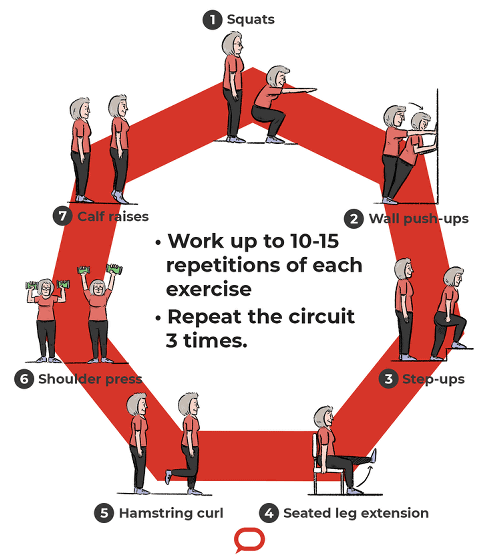
The details of the training are as follows:
1. Squats

2. Wall Push
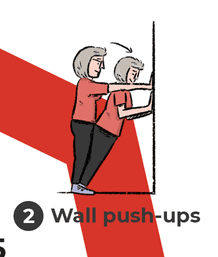
3. Going up and down steps
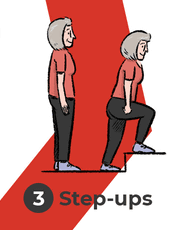
4. Bend and stretch your legs while sitting
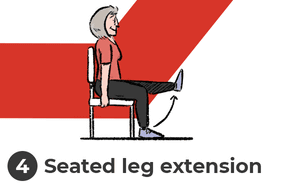
5. Stand and raise your legs backwards
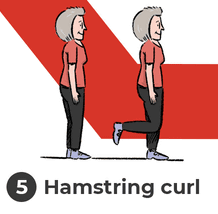
6. Hold weights and raise your arms from your shoulders
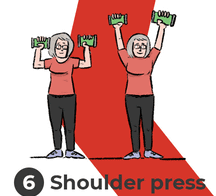
7. Tiptoe Standing
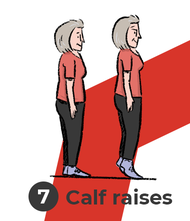
The key to these exercises is to maintain a constant tempo, for example, taking two seconds for each movement. If you don't have dumbbells as weights, you can use a water bottle instead. If you have diabetes, check your blood sugar levels before, during, and after exercise, and do not inject insulin into your exercising limbs. Also, if you have any heart conditions, it is important to warm up and cool down properly and take a 45-second break after each lap of training.
Related Posts:
in Free Member, Note, Posted by darkhorse_log







